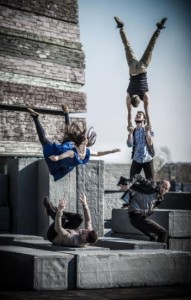There’s something uniquely exhilarating about seeing spectacle through a child’s eyes. Children are transparent, they don’t hide their thoughts and feelings. So when they think something’s good, you know about it. The audience for Block at Pontio on Sunday afternoon was almost entirely made up of young families, with most of the onlookers under the age of 10. And the wonder, excitement and fun these children were having watching this mix of dance and circus was electric.
Block is a collaboration between Wales’s own circus performance outfit NoFit State and Leamington Spa-based dance theatre company Motionhouse, and fuses the aesthetics and disciplines of both into one thrilling 45-minute show.
It’s designed to be performed in the open air, taking as its theme the city and its changing face. Using 20 oversized prop blocks, the seven performers portray various inner city and urban scenarios which connect with the human experience. The city can be many things: threatening, daunting, dangerous, exciting, celebratory, busy, empty. You name it.
The difference with Sunday’s performance was that the weather outside was too wet and blustery for it to be staged in Pontio’s loading bay, as planned, so the whole thing was moved undercover into the Bryn Terfel Theatre. This gave the performance a different dynamic straight away. Block is meant to be experienced within the context of the location, whether that’s a car park, a waterfront or a playground in the middle of a housing estate. The location informs the context of the piece. So when it’s suddenly moved indoors, within the confines of a theatre space (especially vertically), Block becomes something different. The shifting cityscape becomes more of a theatrical experience, rather than an organic one, and the lens through which the audience sees the show is filtered. They subconsciously understand that what they are watching is a distinctly theatrical performance, and that the moments of sudden danger sewn into it are more than likely intentional.
But seeing Block indoors does not remove it of its power. It’s a real spectacle to behold, as the performers leap, spin, tumble, slide and climb around both the stage and the shifting block structures, using every inch of the floor space and never letting up the energy and enthusiasm. Designer Deborah McShane’s blocks (they look solidly granite but are actually weighted sprung mini-platforms) can become anything – streets and pavements, walls, doors, archways, towers and even ruins. At any one time the eye might see a skyscraper or Stonehenge, an office block or a domestic house. They are mini mirages in the hands of the performers, never any one thing for too long, but always something and everything.
It goes without saying that the artistry of the performance is impressive. The concentration these performers have while also providing apparently free-form moves and vocal audience interaction is masterful. When you’ve got a room full of six-year-olds gasping “Wow!” and “Oh my…!” every time someone leaps from a great height only to be caught by a passing pair of hands, it must be hard to stay in the zone. Make no mistake, it would take just one wrongly-positioned camera flash or stray front-row leg for certain sections to take a tumble.
The 45 minutes begins with the performers skittering about the stage, in and around the blocks, as arched bridges which may or may not be insects, the creepy-crawlies and cockroaches that we all know are living with us in our cities – among us, around us, beneath us – and which will always be our inheritors long after Mankind has destroyed himself. Their animalistic beginnings develop into various human experiences of the city – walls rise before them, doors slam to block their way – and we see lonely pedestrians braving the vast city as a desert, children sliding around the playground, police arresting and frisking suspects, even a Berlin Wall that some make it over, and others don’t.
The final 10 minutes is an exercise in theatrical euphoria. There’s sadly no credit for the music, but as the score rises to a tribal crescendo reflecting the city as festival host, the performers build their 20 blocks higher and higher into a Babel-esque tower which they thread in and out of, up and around and through, dangling and swinging, balancing upside down and tumbling to within an inch of danger. The audience wills them to build the tower as high as possible – something that must work even better in the open air – and then the tower topples into ruins. What this falling tower represents might be patently obvious (ie, the Twin Towers) or it might be symbolic of the rise and fall of civilisation, as the performers revert to their earlier primitive forms, scuttling around the ruins. The building blocks of life are scattered, but life will always win in the end.
Block is a stunning fusion of circus chutzpah and contemporary dance creativity. You can see both disciplines in the mix, perhaps the circus more so, but such a show demonstrates how different forms can enhance the whole experience of a piece. The entire experience is probably best seen outdoors, where the danger element is cranked up to the max (it’s automatically more heart-in-mouth when it’s outdoors), but the children present were lapping it up, giving voice to what was held back in every adult’s mind – simply “wow!”
BLOCK is touring Wales throughout the summer, from July 23rd… http://www.nofitstate.
Photography: DAN TUCKER.


Share